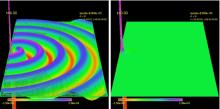
Abstract
Traditional black-hole binary puncture initial data is conformally flat. This unphysical assumption is coupled with a lack of radiation signature from the binary's past life. As a result, waveforms extracted from evolutions of this data display an abrupt jump. In Kelly et al. [Class.Quant.Grav.27:114005,2010], a new binary black-hole initial data with radiation contents derived in the post-Newtonian (PN) calculation was adapted to puncture evolutions in numerical relativity. This data satisfies the constraint equations to the 2.5PN order, and contains a transverse-traceless "wavy" metric contribution, violating the standard assumption of conformal flatness. Although the evolution contained less spurious radiation, there were undesired features; the unphysical horizon mass loss and the large initial orbital eccentricity. Introducing a hybrid approach to the initial data evaluation, we significantly reduce these undesired features.